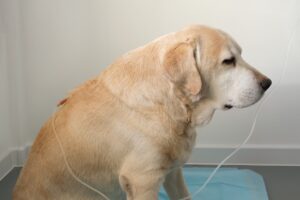How the Kidneys and Bladder Function
The urinary system filters blood, removes waste products, and maintains fluid and electrolyte balance. This vital system allows a dog’s body to dispose of excess substances that could otherwise build up to toxic levels. The two main organs are the kidneys and the bladder, supported by additional structures that ensure waste is transported and expelled effectively.
- The Kidneys:
The kidneys are two bean-shaped organs in the abdomen near the spine. They are critical in filtering waste products from the bloodstream, regulating water and salt levels, and maintaining acid-base balance.- Blood Filtration: Inside each kidney are numerous tiny filtering units called nephrons. These nephrons extract waste products like urea, creatinine, and excess minerals and water from the blood. What remains is a concentrated fluid: urine.
- Fluid Balance and Hormonal Regulation: Beyond removing waste, the kidneys help regulate blood pressure by adjusting fluid volumes and releasing hormones like renin. They also produce erythropoietin, a hormone that stimulates red blood cell production, ensuring the body’s tissues receive adequate oxygen.
- Toxin Removal: The kidneys process metabolic waste and toxins introduced by medications or chemicals. Their constant work keeps the internal environment stable, allowing the dog to maintain a consistent state of health.
- The Bladder and Urinary Tract:
Once urine is produced in the kidneys, it flows through two slender tubes called ureters to the bladder. The bladder is a hollow, muscular organ that stores urine until the dog is ready to urinate.- Storage and Elimination: The bladder’s elastic walls allow it to expand as it fills. When it’s time to urinate, muscles in the bladder contract while the urethral sphincter, a muscular valve, relaxes, allowing urine to flow through the urethra.
- Control and Signaling: While urination can be influenced by the dog’s conscious control, it’s also regulated by reflexes triggered by the stretching of the bladder walls. The nervous system works with the urinary tract to ensure the bladder empties fully and efficiently.
The proper function of the kidneys and bladder is essential for overall health, as any disruption can quickly lead to discomfort, infection, or more serious health issues.
Overview of Male and Female Reproductive Anatomy
The reproductive system in dogs serves both the biological function of producing offspring and, in some cases, contributes to hormone-related behaviours. Male and female dogs have distinct anatomical structures, each tailored to their respective roles in reproduction.
- Male Reproductive Anatomy:
Male dogs possess several key structures that produce and deliver sperm:- Testes: Housed within the scrotum, the testes produce sperm and testosterone. Testosterone influences fertility and specific secondary sexual characteristics and behaviours, such as marking territory or increased interest in females.
- Epididymis: This structure lies along the surface of each testis. It stores and matures sperm cells, making them capable of fertilising an egg.
- Vas Deferens and Accessory Glands: The vas deferens transports sperm from the epididymis to the urethra. Along the way, accessory glands add fluids to the sperm, creating semen. These fluids provide nutrients and help transport sperm through the female reproductive tract.
- Penis and Bulbus Glandis: The penis contains the urethra, which serves as a common passageway for both urine and semen. The bulbous glandis, unique to dogs, swells during mating to create a “tie” that helps ensure sperm is delivered effectively.
Overall, the male reproductive system is streamlined for producing, storing, and delivering sperm to a receptive female.
- Female Reproductive Anatomy:
Female dogs have a more complex reproductive system designed to nurture and protect developing offspring:- Ovaries: The ovaries are paired organs that produce eggs (ova) and estrogen and progesterone hormones. These hormones regulate the oestrous cycle and prepare the body for a potential pregnancy.
- Fallopian Tubes and Uterus: Once an egg is released from the ovary, it travels through the fallopian tube, where fertilisation by sperm typically occurs. The fertilised egg then moves into the uterus, a muscular organ capable of expanding to accommodate multiple developing puppies.
- Cervix and Vagina: The cervix is a tight, muscular passage that separates the uterus from the vagina. During mating, it relaxes to allow sperm to enter the uterus. The vagina serves as both the entryway for sperm and the birth canal through which puppies are delivered.
- Estrous Cycle (Heat): Female dogs undergo regular estrous cycles, commonly referred to as going into “heat.” This is the period when they are receptive to mating. The cycle has several stages, including proestrus (preparation), estrus (fertility window), diestrus (post-ovulation), and anestrus (rest period).
Together, these structures and cycles enable female dogs to produce, carry, and give birth to litters of puppies.
Common Issues Like Urinary Infections and Breeding Concerns
Problems within the urinary or reproductive systems can significantly impact a dog’s health and well-being. Some issues are more common than others, and early detection is key to successful treatment and prevention.
- Urinary Infections and Problems:
- Urinary Tract Infections (UTIs): UTIs occur when bacteria enter the urinary tract, causing inflammation and discomfort. Symptoms include frequent urination, straining to urinate, blood in the urine, and accidents in the house. Prompt antibiotic treatment and good hygiene can prevent complications like kidney infections.
- Bladder Stones and Crystals: Mineral imbalances in the urine can lead to the formation of crystals or stones in the bladder. These can cause pain, difficulty urinating, and, in severe cases, a complete urinary blockage. Dietary changes and increased water intake often help manage and prevent stones.
- Incontinence: Some dogs, especially as they age, may develop urinary incontinence, leaking urine without control. This can result from weakened bladder muscles, hormonal changes (such as those following spaying), or nerve issues. Treatment may involve medication, dietary adjustments, or, in rare cases, surgery.
- Breeding and Reproductive Concerns:
- Pyometra: A potentially life-threatening infection of the uterus, pyometra is more common in older, unspayed females. It often occurs after a heat cycle and can cause lethargy, fever, abdominal swelling, and discharge. Immediate veterinary attention is crucial, and spaying is the most effective prevention.
- Male Fertility Issues: In males, fertility problems may arise from low sperm counts, infections, or blockages. Regular veterinary check-ups and proper care can help maintain reproductive health.
- Dystocia (Difficult Births): Certain breeds, particularly those with large heads or narrow pelvises, are more prone to complications during whelping. Signs of dystocia include prolonged labour, straining without delivering puppies, or unusual discharge. Veterinary assistance may be needed to ensure the safety of both the mother and the pups.
- False Pregnancy (Pseudopregnancy): Some unspayed females may show signs of pregnancy, such as weight gain, nesting behaviour, and milk production, without actually being pregnant. While generally harmless, repeated false pregnancies can lead to stress or complications over time.
By understanding the normal function of the urinary and reproductive systems and the common conditions that can affect them, owners can provide better care and seek prompt treatment when needed. Regular veterinary check-ups, proper hygiene, and a well-balanced diet go a long way in maintaining these essential systems.

